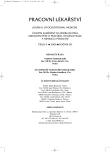New Options in Diagnostics of Neuropsychical Disorders in Workers Exposed to Vapours of Elementary Mercury
Authors:
D. Žilinská 1; E. Gáliková 1; D. Šútorová 2; R. Mikulková 1; J. Garajová 1
Authors‘ workplace:
Klinika pracovného lekárstva a toxikológie UK JLF a MFN Martin
1; Neurologická klinika, Psychologická ambulancia UK JLF a MFN Martin
2
Published in:
Pracov. Lék., 58, 2006, No. 4, s. 148-152.
Category:
Original Papers
Overview
Neurotoxic effect of mercury in chronic exposure is manifested at the psychic level first. The aim of the study was to find out the effect of exposure to vapours of elementary mercury in workers of chemical works in the region of Horna Nitra in a preclinical stage and find out the relevance of psychological examination at diagnostics of neurotoxic effect of mercury. Besides the complex clinical examination including toxicological examination of blood and urine using a method of nuclear absorption spectrophotometry, the authors have undertaken psychological examination using a CORNELL-INDEX-3 questionnaire adapted by Fickova, which maps certain areas of experienced difficulties and behavior. They compared the occurrence of patognomic symptoms of particular areas in relation to the duration of exposure and age by the regression correlation analysis. The authors examined 85 workers with an average age of 41.6 ± 8.0 years, with an average exposure to mercury of 18.5 ± 9.2 years. The average level of mercury in blood was 0.114 ± 0.380 μmol.l⁻¹, in urine 0.138 ± 0.149 μmol.l⁻¹. The results of biological exposure tests were compared with the results in a control group of 20 firemen working without exposure to mercury and other neurotoxic substances in the same region with and average age of 40.8 ± 8.7 years. Significantly higher scores were not found by a screening psychological examination in none of the examined area. The significantly higher occurrence of patognomic symptoms in relation to increasing length of exposure was not found.
Key words:
mercury, psychological examination, neurotoxicity, neurobehavioural aspect
Labels
Hygiene and epidemiology Hyperbaric medicine Occupational medicineArticle was published in
Occupational Medicine

2006 Issue 4
Most read in this issue
- Diseases Caused by Hyperbaric Conditions
- New Options in Diagnostics of Neuropsychical Disorders in Workers Exposed to Vapours of Elementary Mercury
- Primary Prevention of Cardiovascular Diseases in Employees of a Big Hospital
